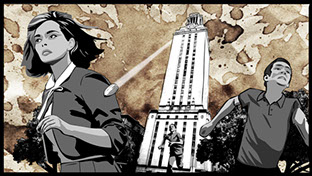
Tragic Tower
Directed by Keith Maitland, Tower is as instructive as it is enlightening, but there is no way an audience will feel anything as blithe as entertainment while watching this moving memorial to the victims (living and dead) of this massacre. There have been productions based on the Whitman’s murderous attack before: An early Peter Bogdanovich thriller called Targets; an artsy 90s avant-garde comedy called The Delicate Art of the Rifle; and even a fumigation-centered episode of King of the Hill.
anything as blithe as entertainment while watching this moving memorial to the victims (living and dead) of this massacre. There have been productions based on the Whitman’s murderous attack before: An early Peter Bogdanovich thriller called Targets; an artsy 90s avant-garde comedy called The Delicate Art of the Rifle; and even a fumigation-centered episode of King of the Hill.
Tower is the only representation of the tragedy to recommend to anyone who wants to learn about the slaughter and feel pride over the heroism shown on a day marked by the senselessness of a man shooting at people as if they were plastic ducks on a carnival conveyer belt. It’s a rare blend of experimentation and documentation, with animation, re-enactment, actual news footage, and real life interviews with the survivors. Viewers come to learn just how random the violence was, and be schooled on how heroic ordinary men and woman can become under hellish circumstances.
Visually, the documentary recalls the work of Richard Linklater, the Austin-based director whose Waking Life introduced audiences to a new possibilities of rotoscopic animation, a technique that Maitland employs to create the distance required to recreate the terror and have the action look like the nightmare it must have been.
But Tower is a painful yet very necessary movie to watch, if only to learn about what was affectively the beginning of a certain kind of gun madness in our culture. One is moved by the facts, by the brave news of cops and poets and students and chess players trying to live in a zone of supremely targeted mayhem.
The film also spreads information that many might never have considered.
We learn that the one of the surviving people shot by Whitman was a Latino paperboy named Aleck Hernandez Jr. This boy, who was very happy to have the University route that day, was shot off his bicycle. Interviews with Hernandez that come at the end of the film focus on the closure he has skirted past for fifty years and inform deeply about the Latino working class that existed in Austin in the 60s. And we meet Ramiro “Ray” Martinez (Louie Arnette), a police officer who with the help of Houston McCoy (Blair Jackson) heroically took out the sniper.
Tower, with its emphasis on a more innocent America and the heroism that can exist amid crisis, also shares an aspect of inclusiveness that comes as an instructive balm at the end of an election year that has been a nightmare for most Latinos. Watching this masterful documentary, one is heartened by the information that the Mexican-American officer who helped to bring down Charles Whitman learned how to accomplish this by serving his country in the U.S. Army.